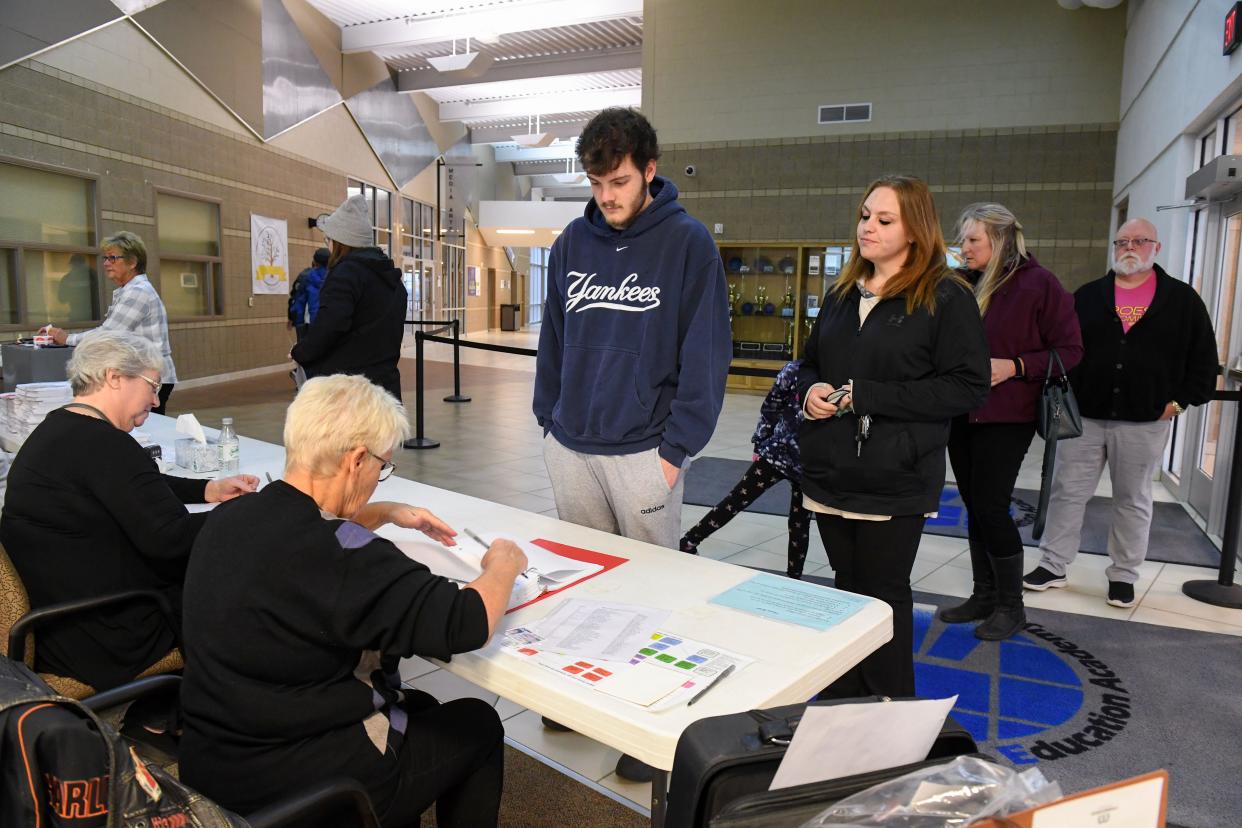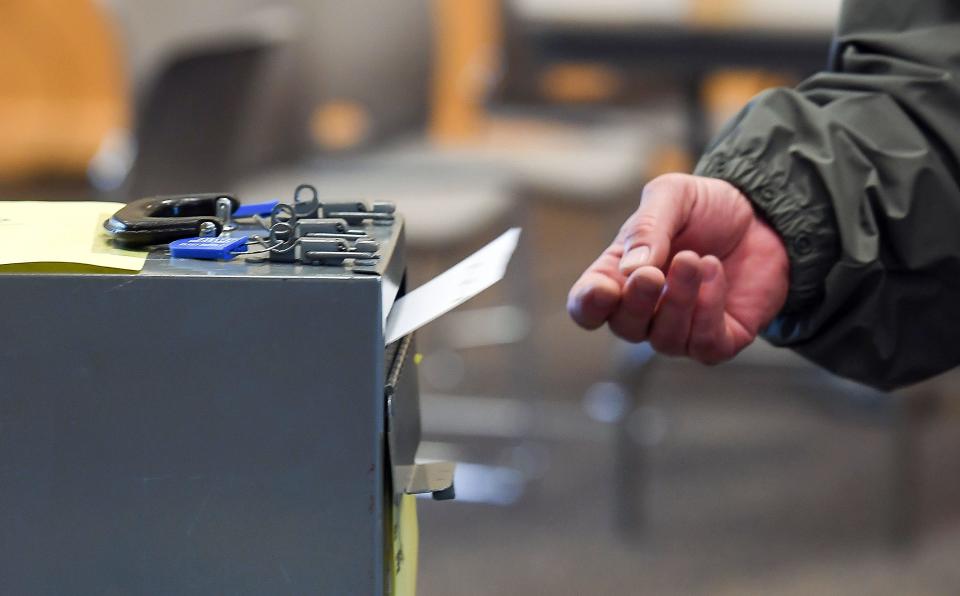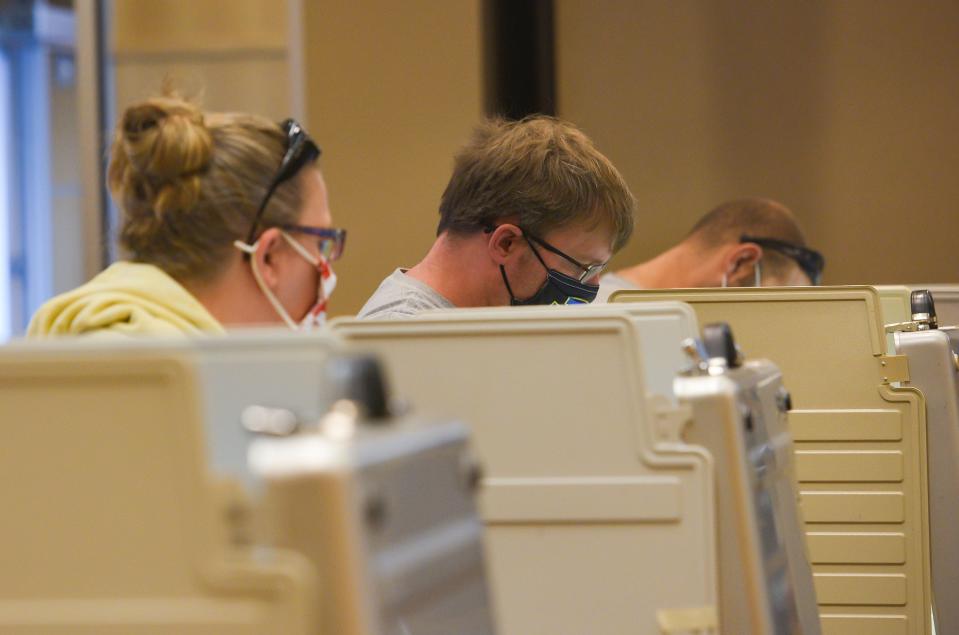‘Future’ of voting unrealized: Few SD counties adopt vote centers and e-poll books

Vote centers and electronic poll books were touted as the future of voting in South Dakota more than a decade ago.
The state was one of the first to allow counties to establish vote centers where anyone in the county could vote on Election Day, regardless of their residential address or precinct.
Vote centers require electronic poll books, which replace large paper volumes of voters’ names, allowing election officials to scan a driver’s license to more quickly verify people’s eligibility to vote. The software prevents people from voting twice in different locations and allows officials to get live updates about voter turnout. An e-poll book is not electronic voting.
Advocates of vote centers say the switch makes voting easier and more accessible, possibly leading to an increase in voter turnout, and say that vote centers and electronic poll books save on election costs.
The Legislature resoundingly supported the enabling vote center legislation in 2012, with only one nay vote out of 105 legislators.
“The idea behind it is that people are busy with their lives. Let’s make voting as convenient as possible,” said prime sponsor of the 2012 bill and former Sen. Todd Schlekeway, R-Sioux Falls, at the time.
Yet the technological wave anticipated a decade ago has been slow to build. Only nine of South Dakota’s 66 counties switched to vote centers, and only 10 counties use electronic poll books. South Dakota is one of 17 states to allow counties to use vote centers on Election Day.
Costs for purchasing electronic poll books are one of the biggest factors affecting a county’s decision to switch, while some counties use alternative voting methods to improve voter accessibility.

Vote centers favored in rural areas with long commute times
Oglala Lakota County, which is on the Pine Ridge Reservation in southwest South Dakota, consistently has the lowest voter turnout in the state. General elections hover around 30-35% turnout.
The county commission switched to vote centers in 2022, after nearly a decade of saving money for the expense and persuasion from Sue Ganje, auditor for Fall River and Oglala Lakota counties.
“It was a no-brainer,” said Ganje, who is based in Hot Springs. “It’s such a large county and there’s such distance between polling locations. It allows them to vote where it’s convenient.”
Oglala Lakota went from nine precincts across the 2,097-square-mile county to eight vote centers. The move wasn’t focused on saving money (usually by significantly cutting down on polling locations), but rather on voting accessibility.
For example, Ganje said, people commuting to work from Kyle to Pine Ridge, which is fairly common in the area, had a 50-minute commute to get back to their precinct before polls closed. She also sees several residents driving to or from Rapid City for appointments or work, so stopping at a vote center on the way to or from Rapid City is more convenient than scheduling their day around voting at their precinct.
While the county didn’t see an immediate improvement in voter turnout, Ganje is hopeful it’ll improve over the next few election cycles.
“It’s the best thing I think that could happen for them down there,” Ganje said.
Haakon County, on the other hand, switched to vote centers in 2020 and saw an increase in its 2022 voter turnout from the 2014 and 2018 midterm elections. Auditor Stacy Pinney said the county won’t go back.
“Not if I can help it,” Pinney said.
Tuesday is sale day in the western South Dakota county, home to Philip, where ranchers sweep into town each week to visit the auction barn. Instead of driving back to their rural precincts in time to vote, ranchers and their families can vote while they’re in town, Pinney said.

Vote centers prioritize convenience over accessibility, official says
Sioux Falls School District has used vote centers since the Legislature approved a pilot project in 2010. But the school district’s voter turnout remains in the single digits despite the switch.
“Turnout might not have increased significantly, but that’s because of the voters and not the opportunities,” said former Secretary of State Jason Gant, who was a proponent of vote centers in the early 2010s. “It’s all about making sure we can do anything to help people vote if they choose to vote.”
Gant currently serves as Charles Mix County auditor in south-central South Dakota. While the county still adheres to traditional precinct polling, Gant is hoping to switch to vote centers during his tenure.
In 2012, the City of Sioux Falls used vote centers, cutting precincts from 59 to 12.
“We lost voters, if I recall,” said former City Councilman and current Minnehaha Commissioner Dean Karsky, “because they went to where they normally voted and no one was there. It confused people more than it helped.”
The city quickly pivoted back to precincts and does not use electronic poll books. Minnehaha County has never used electronic poll books or vote centers.
Bob Litz, former Minnehaha County auditor, introduced the idea of e-poll books and vote centers to county commissioners when it first became an option in 2012. He planned to cut the county from 71 precincts to 22 vote centers, he told South Dakota Searchlight. But commissioners did not support the idea.
Current Minnehaha Auditor Leah Anderson is planning to increase the number of precincts in the county from 75 to 83.
“I believe precincts uphold the integrity of our elections,” she said.
Karsky agreed. Vote centers prioritize convenience over accessibility, he said, specifically in urban areas. Ideally, he believes residents should be able to walk to their polling place from their homes.
“If you went down from 80 precincts by neighborhood to 20 regionalized vote centers, you’re going to limit people who have mobility and transportation issues,” Karsky said. “You’re taking voting accessibility away from those people more than you’re giving it to others.”
Cell service, costs & drive time deterrents in switch
Some counties have shied away from vote centers and e-poll books because of a lack of internet and cell service accessibility. Beadle County, for example, relies on polling places in tin buildings in rural parts of the county, which interferes with connectivity, said Auditor Jill Hanson.
In 2018, eight counties using e-poll books couldn’t properly connect during the primary that year, leaving citizens to cast provisional ballots. The snafu led to a law requiring counties using e-poll books to keep paper poll books on hand in case internet service is cut off.
Pennington County used e-poll books that year, but the county has never switched back to e-poll books. Auditor Cindy Mohler said she’s not entirely opposed to e-poll books and vote centers, but she’s concerned about providing enough ballots to all vote centers across the third largest and second most populated county in the state — especially since it would be a 50-mile drive from Rapid City to deliver more ballots to Wall, on the eastern edge of the county.
The greatest election expense for counties switching to vote centers is purchasing or leasing e-poll books.
Brown County, which is home to Aberdeen, bought 33 electronic poll books for 12 vote centers in 2021 for a total of roughly $45,000.
Hughes County, home to Pierre, bought 23 e-poll books for five vote centers for about $41,000.
Sully County, where some residents commute to Pierre for work, has a quote from an election technology company to replace its e-poll books: seven e-poll books for three vote centers will cost around $14,000 total. Auditor Susan Lamb said it’s a worthwhile investment.
“I think we’d have a hard time if we went back to voting by precinct,” Lamb said. “I don’t think our taxpayers would be very happy with us. It’d cost them more time and it’d be more of an issue where they like the convenience of vote centers.”
Vote centers could cut election costs in half, officials say
In the first year the Sioux Falls School District switched to vote centers, it cut costs by about $38,000, Rep. Charles Hoffman, R-Eureka, told legislators in support of the 2012 bill. The county cut polling places from 58 to 10 across the district, cutting 262 precinct workers to 72.
Each precinct or vote center across South Dakota typically has between three to five poll workers on Election Day.
“Those are real dollars, my friends, that can be spent somewhere else,” Hoffman told legislators in 2012.
Sioux Falls School District Business Manager Todd Vik, who has been with the district for over two decades, guessed that it would cost the district double each election if they switched back to precincts.
The district leases e-poll books for each election, Vik said. He estimated it costs over $20,000 to lease the devices, which includes support and software, for one election.
Minnehaha County employed 346 poll workers during the 2022 election, costing nearly $68,000 for their time, according to data received by South Dakota Searchlight. The cost to rent space for 61 polling locations (some precincts are combined at one building) was just under $5,000.
If the county cut its precincts nearly in half to 40 vote centers it’d save $36,800 in labor, though it would still have printed poll book and ballot costs. Auditor Anderson received a quote for e-poll books earlier this year, estimating a cost of $390,625 upfront for 225 e-poll books and $32,000 a year for software updates. Even with a cut to 108 e-poll books among 40 vote centers, it’d cost the county $187,500 upfront.
Anderson added that a switch to vote centers would increase the cost of ballots because the county would print more, since they wouldn’t know how many people to plan for at each vote center.
Although the e-poll books would only be used every other year, the county still has to pay for yearly software updates, Anderson said, just as the county already does for its other election technology.
“We spend about $40,000 in a non-election year just to have tabulators and express vote machines sitting in storage,” Anderson said.
Alternatives to vote centers
Custer County in western South Dakota has invested the money into e-poll books for its 10 precincts. Yet the county hasn’t considered switching to vote centers.
Instead, the county combines three of its 10 polling places into the same building in the city of Custer as a super precinct, said Deputy Auditor Barb Cox. That’s not the same as vote centers, though, since county residents must still vote in their assigned precinct.
Beadle County also uses a super precinct in the Huron arena, combining six of its nine precincts in the same building.
“If you’re at the wrong polling place you just go across the arena floor to another,” Auditor Hanson explained.
The county uses the super precinct method because it’s more convenient for in-town voters and requires less organization to rent out locations. However, it still requires the same amount of poll workers required of the precinct system.
Hanson hasn’t considered vote centers because they’d require purchasing e-poll books and wouldn’t be accessible with poor cell service in rural areas of the county.
Auditors in some counties that haven’t switched to e-poll books or vote centers said it’s because they can’t use federal funds to purchase e-poll books, and some said they wish the state had grants to supplement material costs.
Bob Litz, former Minnehaha County auditor, pushed for more technology to be used in the county during his tenure. Now retired in Arizona and working as a private contractor on election machines across the country, Litz predicts that the electronic wave will still come, just more slowly than anticipated. Current political pressure from an “election integrity” movement to move away from technology and back to paper ballots could slow down the transition, Litz said.
“I think when more people involved with technology come into being and help with elections, you’ll see that switch to e-poll books and vote centers,” Litz said. “I think the people who don’t like vote centers will age out.”
South Dakota counties using vote centers
Brookings
Brown
Haakon
Hughes
Hyde
Oglala Lakota
Potter
Sully
Yankton
This article originally appeared on Sioux Falls Argus Leader: Few SD counties adopt vote centers and e-poll books

